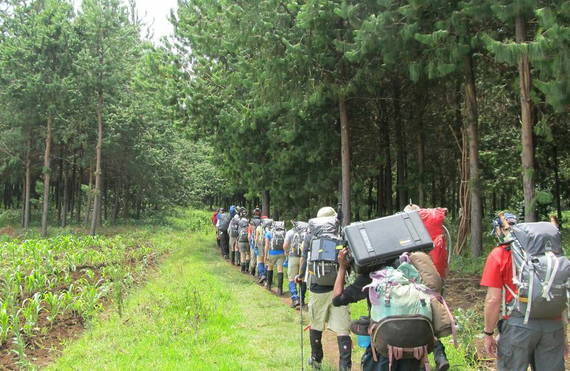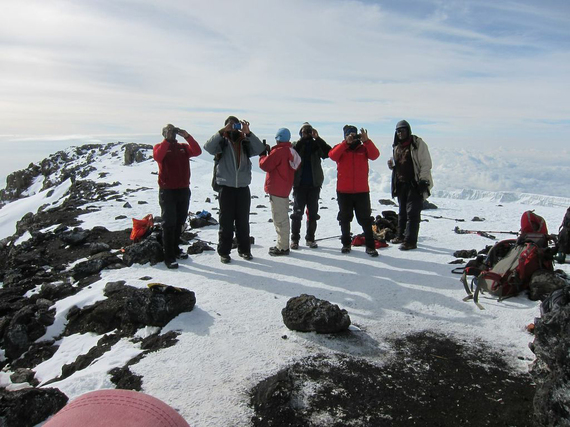I recently traveled to Tanzania, Africa, to climb a mountain and fall in love. But it's not what you think.
I tagged along with a group of 15 remarkable men and women who were part of Survivor Summit, a unique organization that leads cancer survivors and their supporters on "life-altering journeys" and raises money for cancer research via the nonprofit LIVESTRONG Foundation. The group included: Doug Ulman, a two-time cancer survivor and CEO of LIVESTRONG; Dr. Matt King, co-founder of Survivor Summit; several inspirational cancer survivors; relatives of those who lost their battle with cancer; and advocates for cancer research. Our mission was clear -- to summit Mt. Kilimanjaro, the world's highest freestanding mountain, and send a message of hope and inspiration to those battling the insidious monster we all know as cancer. Once on the summit, we would honor those who inspired our journey by unfurling banners bearing their names.
We not only committed to reaching the summit but to reaching it together as a single group, not the smaller more efficient groups that typically achieve success on Mt. Kilimanjaro; we would succeed or fail as one. We were in this together, and together we would deliver our message that anything is possible.
But could we actually achieve our goal? There were no experienced mountaineers in our group. In fact, most had never even been camping. This was truly a David vs. Goliath effort of very long odds. Our guide, Chris Warner, is one of only nine Americans to summit both Everest and K2. Warner teaches leadership at the Wharton School of Business and works with U.S. Intelligence Agencies and Fortune 500 companies developing the kind of leaders that make organizations great. Warner has has guided more than 200 international mountaineering expeditions, including a dozen on Mt. Kilimanjaro. "Less than 20 percent of those who attempt Kili actually reach the true summit: Uhuru Point at 19,340 feet above sea level," Warner tells us. "Kilimanjaro is the most underestimated mountain in the world." Getting all 16 in our group to the very top at the same time would challenge us and our resolve in ways nearly unimaginable.
Warner and his Earth Treks associate, Nelson Laur, made it clear from day one that this would be a life-changing and life-challenging event that would require a near Herculean effort to get everyone to the summit and to get us there at the same time. Warner emphasized that the only thing each of us was ultimately responsible for was our attitude. Our individual attitudes would deliver success or conspire to undermine the entire mission.
Warner informed us that there was no such thing as individual resources or individual load. There was only group resources and group load. We would share everything as needed, balancing load and resources as we moved up the mountain to relieve those in duress and support those in need. He told us that our extensive training, our fancy new equipment, our $400 sleeping bags and puffy down jackets would not get us to the top. The only thing that would carry us to the summit together was love. Love for one another was the only fuel powerful enough to lift this group of beginners to the 19,340-foot summit of Africa's highest mountain.
It was, at first, a strange statement to a group of complete strangers. How could we bond that quickly? How could we love one another in just a matter of days? How could we put aside our own fears and insecurities and pay more attention to the needs of others than our own? How could love climb a mountain?
As we began our adventure, Mt. Kilimanjaro rose in the distance. Yes, it was beautiful, but we weren't here to look. We were here to climb, and through that prism, it was a huge, foreboding, snow-covered monolith that seemed impossible to reach let alone climb and summit. We all realized in that moment that it was the perfect metaphor for one facing a cancer diagnosis or other serious life challenge. The path ahead was long, treacherous and uncertain, and the battle would be epic. But with the help of those around us, we would move forward, one step at a time, until the impossible was not only possible but was within our reach.
Over the next six days, we climbed through mud and snow and ice. We made a slow but steady ascent in the rain and the wind. We climbed steep inclines of deep volcanic ash, scrambled over large boulders and stumbled on loose gravel. We slept in small two-person tents, drank purified water and ate warm meals prepared by our amazing staff of Tanzanian cooks.
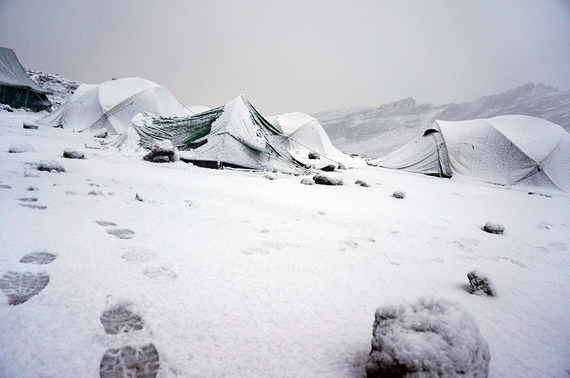
We struggled daily but amazingly, something magical happened on Mt. Kilimanjaro. As we grew weaker, we also grew stronger. As Chris Warner predicted, we began to love one another. It was reflected in the candlelit glow of our evening meals shared in our cold and crowded mess tent, in the quiet chatter as we hiked ever upward, in the unspoken resolve that was evident in everyone's eyes and in the constant question repeated from sun up to sun down, "Are you OK? Do you need anything?" We became a team of givers -- carrying one another's load when necessary, sharing food and supplies, offering encouragement and literally catching one another when we stumbled. It was an effortless level of support that made the grueling effort of climbing ever higher not only possible but amazingly, pleasurable.
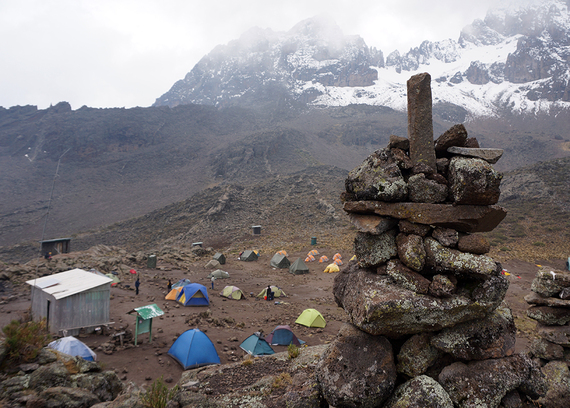
We arrived in high camp on "summit night" exhausted, nervous and breathing deeply in the oxygen deprived environment of 18,000 feet. Five days of climbing and sleeping in extreme conditions had taken its toll. We managed several hours of restless sleep before being awakened at 11 p.m. to begin our final nine-hour assault on Uhuru Point. We learned that only a couple of teams managed to summit the night before -- most were turned back by a driving snowstorm and gusting winds. One man who made it to the summit reported visibility of less than 10 centimeters. He remained on the summit for just a few seconds before heading back down. We all knew that this would be one of the greatest physical and emotional tests we had ever faced. We knew we were being tossed into the grinder. We all knew there was no way we would fail.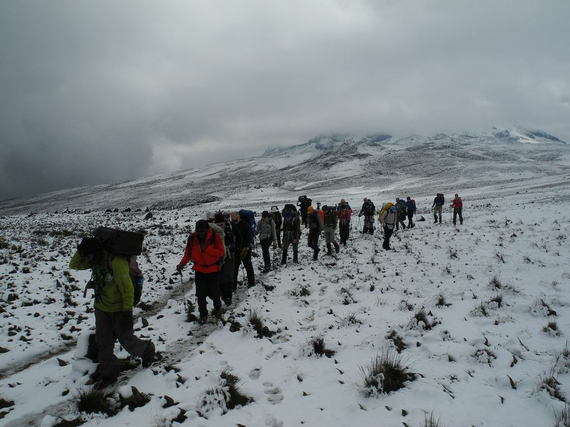
We left camp in a tight, single file, trudging our way through newly fallen snow on an increasingly steep and slippery incline. We were a quiet freight train of determination being led by Arnold, our Tanzanian guide. Chris and Nelson drifted up and down the line like two sheep dogs, offering encouragement and making certain that no one was being overcome by the increasingly hostile environment. As we climbed higher, headaches and nausea set in. Our breathing was so deep, so rapid and so necessary that it was difficult to stop taking in air long enough for a quick but critical swallow of water.
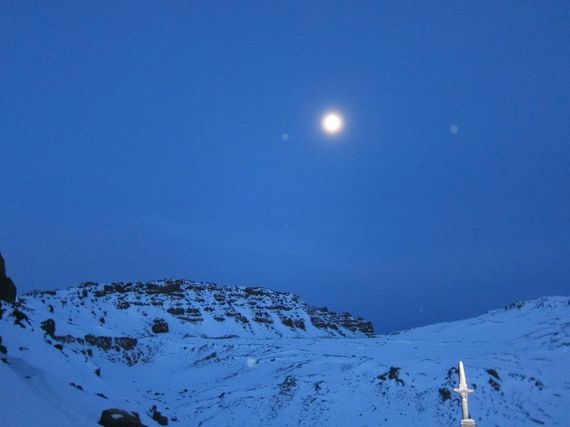
A gorgeous full moon and our headlamps illuminated the endless path before us but it was discouraging to look ahead. There was no end in sight to the constant switchbacks rising up into the blackness. Each step became increasingly painful and then seemingly impossible to take. This was the point where many turn around, where the weight of the challenge exceeds the strength of the team; where the juice is no longer worth the squeeze. We pressed on, taking one impossible step after another. For us, the only way down was up.
Despite a growing case of hypoxia in the oxygen-deprived air, aching muscles, blistered feet, nausea, pounding headaches and constant coughing, there were no complaints, no doubts, no discussion of turning around. There was only a rock solid resolve to finish the task to which we had all committed. Everyone in our group had faced significant personal challenges and understood the power of the human spirit. We were galvanized by our shared desire to reach Uhuru point and to fly our flags on behalf of those who couldn't.
This was the most grueling yet most magical time of the entire expedition. It was a bizarre, surreal experience of being in your body but also existing outside of it. It was a time of extreme personal pain that was somehow absorbed and removed by the energy of the group. There was a very real and palpable power pushing us forward, leading us upward. That power was, unmistakably, love. Chris Warner was right. The immense challenge, the hostile environment, the absolute reliance on one another had forged a bond in just days that created a force that would not be stopped. We had become the perfect example of the whole being far greater than the sum of its parts.
As the sun began to rise, we reached Gilman's point, the first of the three Summits on Kilimanjaro. There was not a single suggestion by anyone that Gilman's was enough. It wasn't. We wanted Uhuru. We needed Uhuru. We pressed on to Stella Point, the second summit on Kili and another landmark at which many turn back, rationalizing (and rightly so) that they have reached a point of significance and earned the right to scramble back down the mountain and relieve their growing symptoms of physical and mental distress. We paused only momentarily at Stella Point to enjoy the magnificence of the morning that was unfolding and to gather ourselves for the final push.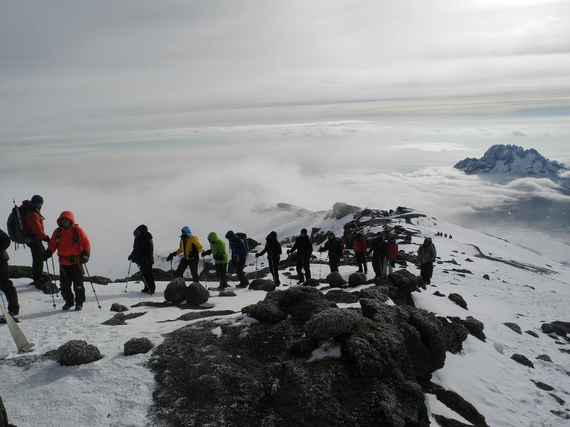
Forty minutes later, after six days of steady climbing, there was nowhere left to go. Not another step to take. We had reached the Roof of Africa: Uhuru Point. We now stood at 19,340 feet, on top of the mountain that one week ago seemed totally out of our reach. Powered by loved and fueled by a passion to shout from the top of Africa's highest mountain that anything is possible, we were instantly energized.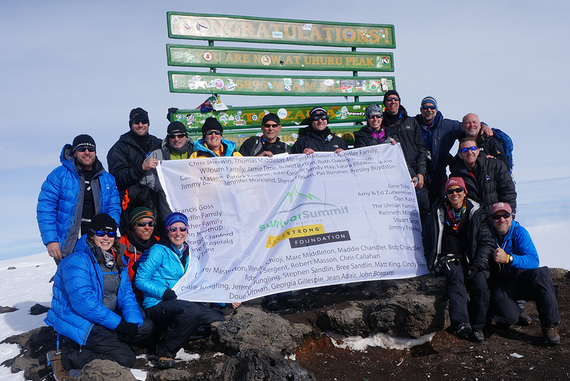
It was a rare and perfect morning on the summit. We were above the clouds and visibility seemed infinite. The sun was shining, the wind was calm and it was actually warm as we marveled at the Furtwangler Glacier, a remnant of an enormous icecap that once crowned the summit. While most are able to remain on the summit for only a few minutes, we stayed for an hour enjoying every moment and unveiling banner after banner with the names of those we were climbing for. Finally, Chris and Nelson, fearing the growing effects of hypoxia, acute mountain sickness and potentially fatal cerebral or pulmonary edema hurried us back down to Stella Point, to Gilman's Point, and ultimately back to high camp where we rested briefly before continuing what would ultimately be a 20-hour day.
Chris Warner was right. It was a life-changing week. The question is, in what way? It will take time to process what we learned from Chris and Nelson, from ourselves, from the others in our group and from the mountain itself. For now, for me, the message is simply what Chris declared on day one -- that only love will get us to the top of the mountain. It was a life lesson worth fighting and suffering for because in many ways, we are all climbing a mountain and the summit seems unattainable. The 16 men and women of Survivor Summit 2014 are here to tell you that your mountain can be climbed and your summit, whatever it may be, is within your reach. All you have to do is tap into the infinite power of love.
Survivor Summit 2104 participants include: Doug Ulman, Dr. Matt King, Dr. Robert Masson, Robert Sergeant, Claire Jungling, Jeremy Jungling, Bree Sandlin, Stephen Sandlin, Wendy Chioji, Chris Callahan, Cindy Trent, Maddie Chandler, Bob Chandler, Chris Warner, Nelson Laur, Marc Middleton
For More information visit:
Survivor Summit
LIVESTRONG

